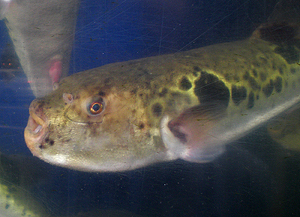 |
Neurotoxins |  |
 |
 |
  Do you know what some spiders,
snakes, scorpions, bees, mussels, and pufferfish have in common? Well,
besides, scaring you, these animals have poisons that act on the nervous
system. These poisons (called neurotoxins) are
used by the animals for protection against predators or for capturing
prey. The table below indicates 1) the names of the neurotoxins, 2) the
animals from which the neurotoxin comes from and 3) the action of the
neurotoxin on a neuron. The word "channel" refers to a type of protein
molecule that different ions use to cross the neuronal membrane. Do you know what some spiders,
snakes, scorpions, bees, mussels, and pufferfish have in common? Well,
besides, scaring you, these animals have poisons that act on the nervous
system. These poisons (called neurotoxins) are
used by the animals for protection against predators or for capturing
prey. The table below indicates 1) the names of the neurotoxins, 2) the
animals from which the neurotoxin comes from and 3) the action of the
neurotoxin on a neuron. The word "channel" refers to a type of protein
molecule that different ions use to cross the neuronal membrane. |
| Now if you ever get bitten or stung by one of these animals, at least you will know what is happening to your nervous system!! |
| Name | Source | Neuronal Action |
|---|---|---|
| Agatoxin | Funnel Web Spider (Agelenopsis aperta) | Blocks calcium channels |
| Agitoxin | Scorpion | Blocks potassium channels |
| alpha-bungarotoxin | Krait (snake) | Blocks acetylcholine (nicotinic) receptor |
| Anatoxin | Algae | Acetylcholine receptor agonist |
| Apamin | Honey bee | Blocks potassium channels |
| Atracotoxin | Sydney Funnel Web Spider | Blocks voltage-gated calcium channels |
| ATX II | Sea Anemone | Activates voltage-gated sodium channels |
| Batrachotoxin | Poison Arrow Frog | Prevents sodium channels from closing |
| beta-bungarotoxin | Krait (snake) | Inhibits release of ACh at neuromusuclar junction and blocks potassium channels |
| Botulinum toxin | Bacteria | Blocks acetylcholine release |
| Brevetoxin | Red Tide Dinoflagellate | Activates sodium channels |
| Calcicludine | Eastern Green Mamba | Blocks voltage-gated calcium channels |
| Calciseptine | Black Mamba | Blocks voltage-gated calcium channels |
| Capsaicin | Cayenne Pepper | Excites peripheral nerve endings |
| Charybdotoxin | Scorpion | Blocks potassium channels |
| Ciguatoxin | Dinoflagellate | Opens sodium channels |
| Cobrotoxin | Cobra | Blocks nicotinic receptors |
| Conotoxin | Marine Snail | Several types: one blocks voltage-sensitive calcium
channels; one blocks voltage-sensitive sodium channels; one blocks ACh receptors. |
| Crotoxin | S. American Rattlesnake | Reduces acetylcholine release |
| Dendrotoxin | Green Mamba | Blocks voltage-gated potassium channels |
| Domoic acid | Blue mussel | Glutamate/kainate receptor agonist |
| Erabutoxin | Sea Snake | Blocks acetylcholine (nicotinic) receptors |
| rErgtoxin-1 | Mexican Scorpion | Blocks potassium channels |
| Fasciculin-I | Eastern Green Mamba | Blocks action of acetylcholinesterase |
| Grammotoxin SIA | South American Rose Tarantula | Blocks calcium channels |
| Gonyautoxin | Dinoflagellate | Blocks sodium channels |
| Holocyclotoxin | Australian paralysis tick | Inhibits release of acetylcholine |
| Homobatrachotoxin | Pitohui (bird) | Activates sodium channels |
| rHongotoxin-1 | Central American Scorpion | Blocks potassium channels |
| HWTX-I | Chinese bird spider | Blocks calcium channels |
| Iberiotoxin | Scorpion | Blocks potassium channels |
| Joro spider toxin | Joro spider | Blocks glutamate receptors |
| Kaliotoxin | Scorpion | Blocks potassium channels |
| Kurtoxin | South African Scorpion | Blocks calcium channels |
| Latrotoxin | Black Widow Spider | Enhances acetylcholine release |
| Maculotoxin | Blue-Ringed Octopus | Blocks sodium channels |
| Mandaratoxin | Asian Giant Hornet | Blocks sodium channels |
| Margatoxin | Scorpion | Blocks potassium channels |
| Maurotoxin | Scorpion | Blocks potassium channels |
| Noxiustoxin | Scorpion | Blocks sodium channels |
| Palytoxin | Soft coral | Poisons sodium/potassium pump; opens channels |
| Philanthotoxin | Predaceous Wasp | Blocks glutamate receptors |
| Phoneutriatoxin | Banana spider | Slows sodium channel inactivation |
| Phrixotoxin | Chilean fire tarantula | Blocks potassium channels |
| Poneratoxin | Bullet Ant | Inhibits inactivation of voltage gated sodium channels |
| Pompilidotoxin | Solitary Wasp | Activates voltage-gated sodium channels |
| Robustotoxin | Funnel web spider | Opens sodium channels |
| Saxitoxin | Dinoflagellate | Blocks sodium channels |
| Scyllatoxin | Scorpion | Blocks potassium channels |
| SNX-482 | African Tarantula | Blocks calcium channels |
| Stichodactyla Toxin | Sea Anemone | Blocks voltage-gated potassium channels |
| rStromatoxin-1 | African Tarantula | Blocks voltage-gated potassium channels |
| Taicatoxin | Australian Taipan snake | Inhibits voltage-gated calcium channels |
| Taipoxin | Australian Taipan snake | Inhibits release of acetylcholine |
| rTamapin | Indian Red Scorpion | Blocks potassium channels |
| Tertiapin | Honey bee | Blocks potassium channels |
| Tetrodotoxin (TTX) | Pufferfish | Blocks sodium channels |
| Textilotoxin | Australian common brown snake | Blocks release of acetylcholine |
| Tityustoxin-K | Brazilian Scorpion | Blocks potassium channels |
| Versutoxin | Funnel web spider | Opens sodium channels |
 A good reference on Neurotoxins is: Trends in
Neuroscience, June 1996, supplement. A good reference on Neurotoxins is: Trends in
Neuroscience, June 1996, supplement.Also see venoms (Society for Neuroscience) and the Snake Venom Database for more information about neurotoxins. There are many chemicals that are also toxic to the nervous system. Just in case you encounter a venomous animals, make sure you know what to do. |
Did you
know? |  Even though the
pufferfish contains the neurotoxin called tetrodotoxin, it is
eaten as a delicacy in Japan. In Japan, this dish is called "fugu."
Each fugu chef must have a special license to make this food.
Nevertheless, a few people do get poisoned from eating the pufferfish>
if it is prepared incorrectly. Tetrodotoxin is found in the liver, skin
and eggs of the pufferfish. Tetrodotoxin has also been detected in
other animals such as the tropical goby, blue ringed octopus, and some
species of crabs, starfish, newts and frogs. [Fugu
Recipes] Even though the
pufferfish contains the neurotoxin called tetrodotoxin, it is
eaten as a delicacy in Japan. In Japan, this dish is called "fugu."
Each fugu chef must have a special license to make this food.
Nevertheless, a few people do get poisoned from eating the pufferfish>
if it is prepared incorrectly. Tetrodotoxin is found in the liver, skin
and eggs of the pufferfish. Tetrodotoxin has also been detected in
other animals such as the tropical goby, blue ringed octopus, and some
species of crabs, starfish, newts and frogs. [Fugu
Recipes] |
 |
Venomous snakes can be dangerous even after they are dead. In a study published in the New England Journal of Medicine, it was reported that 14.7% of the people envenomed by rattlesnakes were "bitten" by snakes that were dead or thought to be dead. |
Try it! |
Think you know your neurotoxins? Try this "Match the Toxin" worksheet. If you have trouble or want to check your answers, here is an answer sheet. Note: both of these pages require the free Adobe Acrobat Reader |
| BACK TO: | Exploring the Nervous System | Table of Contents |
![[email]](./gif/menue.gif) Send |
 Get Newsletter |
 Search Pages |
 Donate to Neuroscience for Kids |